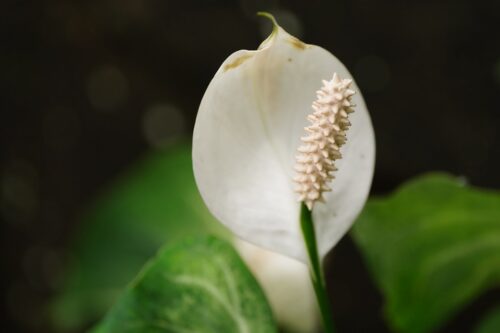If you are worried about your Peace Lily, Not Flowering and Drooping, read this post for the most common reasons and their solutions.
There are many reasons why Peace Lily is Not Flowering and Drooping. Healthy plants are lance-shaped, deep green, and grow directly from the soil. Let’s take a detailed look at all the problems and their solutions.
Peace Lily Not Flowering and Drooping Reasons and Solutions

1. Natural Aging
As the plant ages, lower foliage becomes yellow or brown and dies.
Solution: Once it happens, prune the yellow leaves, and don’t worry about the issue. Use a sharp tool and remove the foliage.
2. Fertilizer Problem
Lack of food, especially nitrogen, can make the leaves yellow in peace lilies; the absence of iron or magnesium can also result in yellow foliage with green veins.
Peace lilies are not heavy feeders; too much fertilizer can cause other problems like; brown tips and no flowers.
Solution: If your peace lily isn’t flowering, it is due to under-fertilization, though it can also happen if the plant is not repotted for many years. Apply half or one-quarter strength of balanced liquid fertilizer every 3-5 weeks in the growing season.
Over-fertilization causes brown leaves. To combat this issue, wash the soil with clean water and use a balanced fertilizer in spring and summer once every 6-8 weeks.
3. Light Exposure
Peace lily dislikes direct sunlight; they thrive in the wild under rainforests. If your plant gets too much sun, the foliage will become brown at the margins or turn yellow entirely with green veins. Also, blooming is affected by the lack of sufficient indirect light.
Solution: Keep the plant in an area with six to eight hours of bright indirect light.
4. Watering Problems
Avoid growing peace lilies in a pot without drainage holes. Overwatering and underwatering are other main causes that can lead to droopy plants and can also be fatal for the plant. If this is the reason behind leaf discoloration, you’ll notice yellow, wilted foliage. In lack of enough water, this plant wilts quickly but recovers, too. Regular underwatering also causes brown leaf tips and margins. This tropical plant prefers slightly moist soil. Consistent soggy soil and poor drainage lead to drooping peace lilies and root rot.
Solution: Always water the plant when the topsoil feels dry to the touch. Use a pot with drainage holes. For an overwatered plant, take it out from the container, cut the damaged roots, and re-pot it in a fresh potting mix that is not moist.
5. Temperature
Changes in location or temperature also stress the plant and make leaves yellow; peace lily dislikes cold drafts and temperatures below 40 F (4 C); this can also cause yellow or pale leaves.
Solution: Peace lily favors a temperature range between 85-80 F (18-27 C); hence, avoid keeping it in a spot that is too hot or cold. In the winter months, keep the plant away from non-insulated windows or doors to protect it from cold drafts. Also, do not keep the plant in front of air conditioners or heaters.
6. Low Humidity
If your peace lily has brown leaf tips, it is due to low humidity. This becomes more common in winter when homes use air-heating vents. A plant kept near the draft, in a warm area, or in direct sun can also lose moisture quickly.
Solution: Peace lilies belong to tropical areas with high humidity, so keep them in areas with 50 percent or higher humidity. Raise the humidity by keeping the plant on a tray filled with pebbles and water, misting the foliage twice daily, grouping plants, or using a room humidifier.
Note: You only need to promote humidity during the year. Avoid adding too much moisture, as it can lead to diseases.
7. Water Quality
Most municipal water systems have chlorine, and in homes with the softening system includes high levels of sodium, which builds up and negatively affects the health of your peace lily. This plant is sensitive to excess salt or chlorine.
Solution: Look at to find your city adds chlorine to the water; if it does, then allow the water to sit overnight so the gas evaporates. Use a water filter, reverse osmosis, or purchase filtered water.
8. Transplant Shock
After transplanting, the plant is under shock if yellowing happens without brown tips. However, transplant shock is not common with this hardy plant. The first sign is wilting, followed by yellow leaves.
Solution: Continue to water and do not expose the plant to extreme light; your peace lily will recover in time. Do not feed and trim off any dead leaves. Keeping the wilted ones on the plant will be alright until it recovers to avoid more stress.
9. Pests and Diseases
Mealybugs (Pseudococcidae family) absorb the sap from the plants, which causes stunted growth. In large numbers, these pests will result in wilted, yellow foliage or brown tips, spots, and margins. Aphids and spider mites also affect the growth of the plant.
Solution: Wipe the leaves occasionally without missing the undersides. To eliminate pest problems, you can also use neem oil or an insecticidal soap solution. You can handpick them manually or strike them with powerful water jets.



